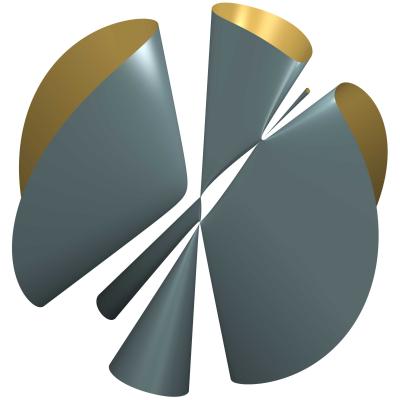Geometry is a central area of modern mathematics. The 3 main strands of our work (described by the keywords) are closely intertwined, through the use of dynamical (symplectic) methods in the study of geometric problems, on the one hand, and the use of geometric methods in the study of problems in dynamics, on the other. We also contribute with applications to Economics and Biology, in the line Mathematical Models and Applications.
In the following each of the 3 strands of our work is described in more detail.
Geometry and topology of algebraic varieties
Roughly speaking, an algebraic variety is the zero set of a collection of polynomials. We study both individual algebraic varieties and universal parameter spaces for individual geometrical objects, called moduli spaces.
We study algebraic surfaces of general type, in particular the ones with small invariants. The focus is on the construction of new examples, using e.g. coverings of small degree, properties of the canonical and bicanonical maps and computer algebra.
Higgs bundles appear naturally in non-abelian Hodge theory, as holomorphic incarnations of representation of fundamental groups of surfaces in a Lie group G. We study geometric properties of the moduli space of Higgs bundles, especially when G is real. We are also interested in other geometric aspects of moduli spaces, linking to e.g. symplectic and tropical geometry.
Geometry and dynamics of real and complex differential equations
Heteroclinic networks form a central theme in our study of real dynamics. They are a source of global complex dynamics and the project aims to contribute to the understanding of this mechanism in and near dynamical systems with symmetry, motivated by many scientifically relevant examples in the area of physics, biology, engineering, etc. Symmetry gives rise to degeneracies, and thus leads to complications in the analysis in comparison to phenomena in the absence of symmetry. The research aims to improve the understanding of the dynamics near heteroclinic networks involving saddle-foci and non-trivial periodic solutions, as well as bifurcation of heteroclinic networks, under the addition of some noise.
In the field of complex dynamics, several difficulties encountered in the study of the geometry and topology of leaves on some well-known problems about singular holomorphic foliations, are essentially concerned with pseudogroups generated by certain local holomorphic diffeomorphisms defined on a neighborhood of 0 in C^n. The study of the dynamics of these pseudogroups is therefore very important. They may allow us to prove integrability for certain systems as well as to detect the presence of chaos in other systems.





